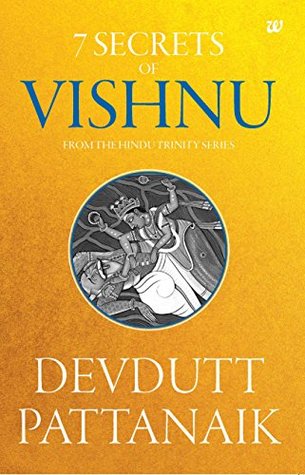Highlights from 7 Secrets Of Vishnu by Devdutt Pattanaik

For me, reading this book was to look at the things that I already knew, from a different perspective — not necessarily the view that I agree with. This book starts with Mohini and goes on to tell the stories of all the mainstream avatars of Vishnu and what the significance of those avatars was, in their respective time periods.
I am an avid mythology buff since I was a little kid, and having gone through a lot of the Hindu mythological scriptures in one form or other, it was enjoyable to see author's diverse use of symbolism. I was astonished by the author's comparison of Lakshmi and Saraswati and how these two always have conflicts with each other. The author tries to relate Devas and Asuras with Lakshmi and Alakshmi with good arguments. Those who do not know, Alakshmi is the sister of Lakshmi, who always accompanies her wherever she goes and represents strife.
The illustrations provided in the book are cherry on the top and provide insights into the ancient architecture of Indian temples with the associated bubbles of explanations. I read this book on my Kindle Paperwhite, so all the illustrations were B&W for me. However, I am not complaining.
Overall, it was a good one time read. I was not able to appreciate some of the ideas and interpretation of the scriptures by the author, but sometimes, thinking from a perspective which you do not like, can be enlightening.
There are a lot of good quotes in this book, which unfortunately I could not note down as I was too engaged in reading this book. So I revisited the book and found out these quotes were worth mentioning (not in specific order).
Notes:
-
Lakshmi is typically drawn towards places where Saraswati resides. That is why prosperity always follows peace. However, when Lakshmi comes, attention shifts from Saraswati to Lakshmi. Enraged, Saraswati leaves. In her absence, Alakshmi comes to give her sister, Lakshmi, company. With Alakshmi comes strife. With strife ends peace. And in the absence of peace, prosperity eventually wanes. Lakshmi leaves and there is nothing left.
-
Devas and Asuras reflect two aspects of human personality: our need for stability and our need for growth. The former makes us either insecure or complacent. The latter makes us frustrated and restless. We crave for Lakshmi mostly. Sometimes we crave for Saraswati, with the sole pursuit of obtaining Lakshmi; for when Lakshmi arrives we ignore Saraswati to our peril. That we experience these emotions is an indicator that we have not yet realised or experienced spiritual reality, which is Vishnu.
-
Evil means the 'absence of God'. This idea does not exist in Hinduism because, for Hindus, the whole world is a manifestation of the divine. So, nothing can be evil.
-
Divinity cannot be limited by human imagination or human memory. There is always something in the universe that surprises us.
-
In the Ramayana, Ram does not lose his composure when he is asked to leave the palace and live in the forest. He is as much at peace in the palace as he is in the forest. He does not derive his identity from material reality. This quality of Vishnu makes him attractive to Lakshmi. Vishnu is therefore called Shri-nivasa or Shri-vatsa, which means abode of Lakshmi.
-
Lakshmi is Vishnu’s bhoga-patni, connecting him with the earthly needs of man. Saraswati is Vishnu’s moksha-patni, connecting him with the spiritual needs of man.
-
Vijaya is conventional victory, victory over the other, over other’s minds, a victory where there are winners and losers. Jaya, on the other hand, is victory over oneself, over one’s mind, a victory where there are no losers.
-
I have not highlighted anything in this ebook.